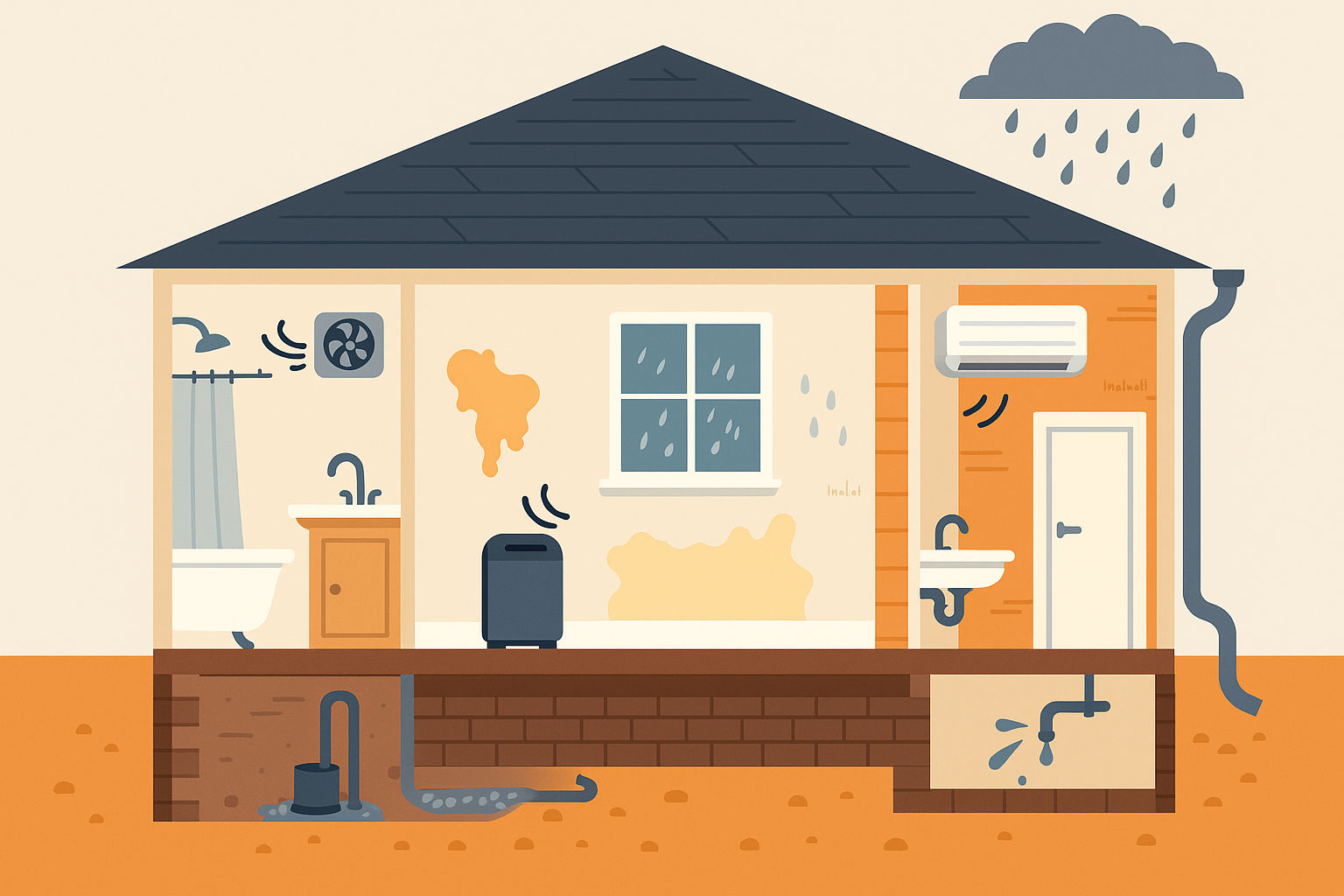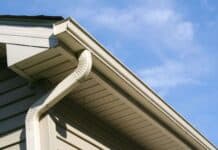
Moisture can be a silent destroyer. You don’t always see it coming — a little condensation on the window here, a faint musty smell there — but left unchecked, it can lead to mould, rot, corrosion, and expensive repairs. The tricky thing about moisture damage is that it rarely happens overnight. It builds up gradually, creeping into walls, ceilings, and floors until it becomes a serious problem.
The good news is that moisture damage is largely preventable. With a bit of awareness and regular maintenance, you can protect your home, appliances, and even your health from the effects of dampness. Prevention is much easier (and cheaper) than remediation, and it starts with understanding where moisture comes from and how to manage it effectively.
Understanding Where Moisture Comes From
Moisture can enter your home or building in more ways than you might expect. Rain and humidity are the obvious culprits, but daily activities like showering, cooking, and drying clothes indoors also release water vapour into the air. Over time, that excess moisture settles on cool surfaces, leading to condensation and, eventually, damage.
Even air conditioners and heating systems can contribute if they’re not properly maintained. These systems naturally produce condensation as they operate, and if that water isn’t drained correctly, it can leak into walls or ceilings. That’s why equipment like condensate pumps are essential — they help remove water efficiently, preventing moisture buildup that could otherwise lead to structural or electrical damage.
By identifying where moisture originates in your environment, you can take targeted action to stop it before it becomes a costly headache.
Recognising Early Warning Signs
Moisture damage often starts small. By catching it early, you can prevent it from spreading. Here are a few signs to look out for:
- Musty odours: One of the first indicators of hidden moisture or mould.
- Peeling paint or bubbling wallpaper: A sure sign that water is trapped behind the surface.
- Discolouration on walls or ceilings: Often yellow or brown stains caused by water leaks.
- Condensation on windows: Regular fogging can mean humidity levels are too high.
- Creaky or warped floors: Timber and laminate floors absorb moisture over time.
- Visible mould growth: Even small patches indicate a deeper moisture problem nearby.
Addressing these signs quickly can save you from much bigger issues later. Think of them as your home’s way of sending out an SOS.
Improve Ventilation
The simplest and most effective way to control indoor moisture is through good airflow. Proper ventilation allows humid air to escape and fresh, dry air to circulate.
Start with the basics: open windows whenever possible, especially after cooking, showering, or cleaning. If you live in a humid area, consider installing exhaust fans in high-moisture zones like bathrooms, kitchens, and laundries. Make sure these fans vent outside — not into the roof cavity — as that just shifts the problem elsewhere.
For rooms without windows, dehumidifiers can be a lifesaver. They pull excess moisture from the air and are especially useful in basements, storage spaces, or coastal homes where humidity levels run high year-round.
Insulate and Seal Properly
Condensation occurs when warm, moist air meets cold surfaces. Insulation helps regulate temperature differences and reduces the likelihood of this happening.
Adding insulation to walls, ceilings, and floors can make a huge difference, especially in older homes. It keeps indoor surfaces closer to room temperature, minimising the chance of moisture forming.
Similarly, sealing gaps around doors, windows, and vents prevents humid outdoor air from seeping inside — and keeps conditioned air from escaping. Use weatherstripping or silicone sealant to close any gaps where you feel drafts or notice condensation forming.
Good insulation not only prevents moisture damage but also improves energy efficiency, lowering your heating and cooling bills in the process.
Manage Indoor Humidity
Humidity is the amount of water vapour in the air, and keeping it in balance is crucial to preventing damage. Ideally, indoor humidity should sit between 30% and 50%.
Too high, and you’ll notice condensation on windows and walls. Too low, and you might experience dry skin and static electricity.
Here are a few practical ways to keep humidity in check:
- Use exhaust fans: Turn them on during and after cooking or bathing.
- Avoid drying clothes indoors: The moisture released can quickly raise humidity.
- Cover pots while cooking: It reduces steam.
- Invest in a hygrometer: This small, inexpensive device measures humidity so you can adjust as needed.
- Use air conditioners or dehumidifiers: Both help maintain a balanced indoor climate.
By managing humidity, you prevent the damp environment that mould, mildew, and rot thrive in.
Protect Vulnerable Areas
Some parts of your home are naturally more prone to moisture problems. Paying attention to these areas can save you significant trouble.
Bathrooms: Always use the exhaust fan and leave the door or window open after showers. Wipe down tiles and mirrors to reduce moisture buildup, and check the caulking around baths, showers, and sinks regularly.
Kitchens: Ensure your rangehood vents outside, and fix any leaky taps or pipes promptly. Regularly clean behind and under appliances like fridges and dishwashers, where unnoticed drips can accumulate.
Basements and Garages: These areas are cooler and often poorly ventilated. Install dehumidifiers, check for cracks in concrete floors, and make sure rainwater drains away from the foundation.
Roofs and Gutters: Clean gutters regularly so rainwater doesn’t overflow and seep into the roof cavity. Inspect roof tiles or shingles for damage and reseal where necessary.
Windows and Doors: Condensation around frames can lead to rot or mould. Use a dry cloth to wipe excess moisture and consider double glazing or thermal curtains for better temperature control.
Address Plumbing and Drainage Issues
Leaks are a leading cause of hidden moisture damage. Even a slow drip can cause major structural issues if ignored.
Check under sinks, around toilets, and near washing machines for any signs of dampness. Fix leaky taps and pipes as soon as you spot them — what seems minor today can become a costly repair tomorrow.
Outside, ensure that water drains away from your home. Sloping your landscaping away from the foundation helps prevent pooling, and installing French drains or soak wells can redirect excess water effectively.
Downpipes should discharge well clear of the house, and stormwater systems should be checked before every wet season to ensure they’re free of debris.
Use Moisture-Resistant Materials
If you’re renovating or building, choosing the right materials can prevent problems down the line. Modern building products are designed with moisture management in mind.
Opt for:
- Water-resistant plasterboard or cement board in bathrooms and kitchens.
- Moisture-proof underlay beneath flooring, especially in basements or on concrete slabs.
- Treated timber for outdoor structures or framing in damp areas.
- Vapour barriers behind walls and under floors to prevent rising damp.
These materials cost a little more upfront but can save you thousands in future repairs.
Keep an Eye on Your Air Conditioning System
Air conditioners do more than cool the air — they also remove humidity. But if not maintained properly, they can become sources of moisture problems themselves.
Check filters regularly and clean or replace them as needed. Inspect drain lines and ensure that condensation is being channelled away correctly. If you notice water pooling near the unit, it could indicate a blockage that needs attention.
Scheduling annual servicing keeps the system running efficiently and reduces the risk of leaks or mould growth inside the ducts.
Act Quickly After Water Events
Sometimes, despite your best efforts, water finds a way in — a burst pipe, heavy rain, or an accidental spill. The key to preventing lasting damage is speed.
The first 24–48 hours are critical. Mop up standing water immediately, and use fans or dehumidifiers to dry the area thoroughly. Remove soaked carpets, rugs, or furniture if possible, as they can trap moisture and breed mould.
If the damage seems extensive, consider contacting a professional water damage restoration service. They have specialised equipment to extract moisture from walls, floors, and insulation, helping prevent long-term structural issues.
Moisture may be inevitable, but damage doesn’t have to be. By maintaining good airflow, managing humidity, sealing leaks, and keeping an eye on vulnerable areas, you can create an environment where dampness doesn’t stand a chance. It’s about staying one step ahead — because when you control moisture, you protect more than just your property; you protect your comfort, your health, and your peace of mind.






